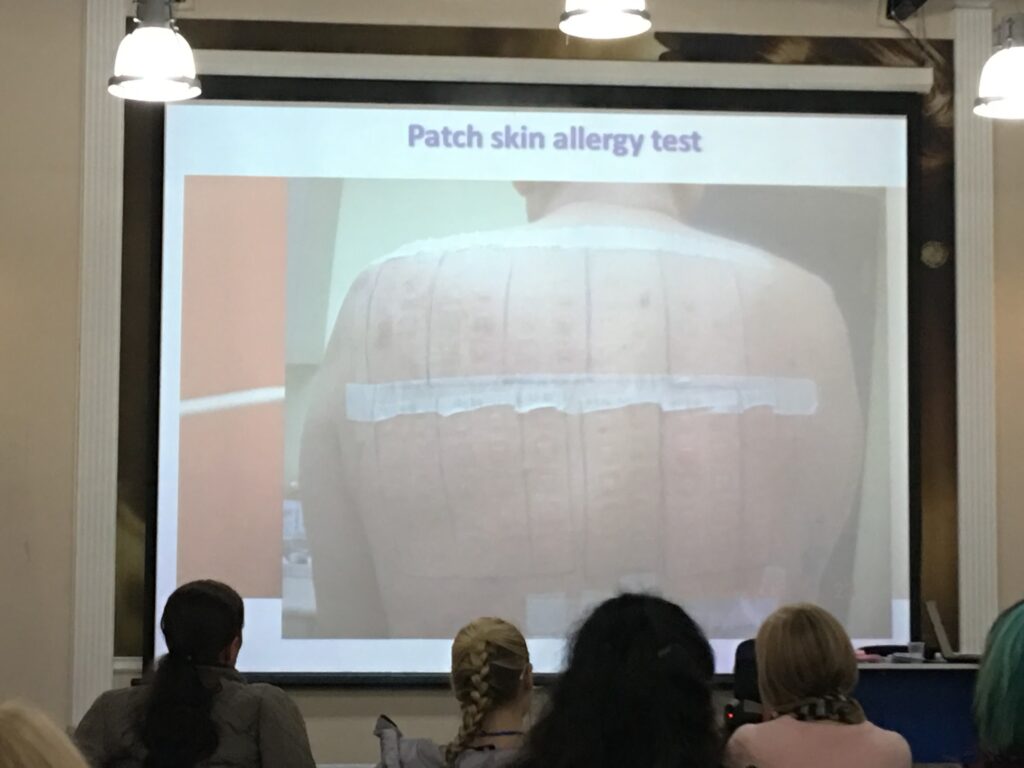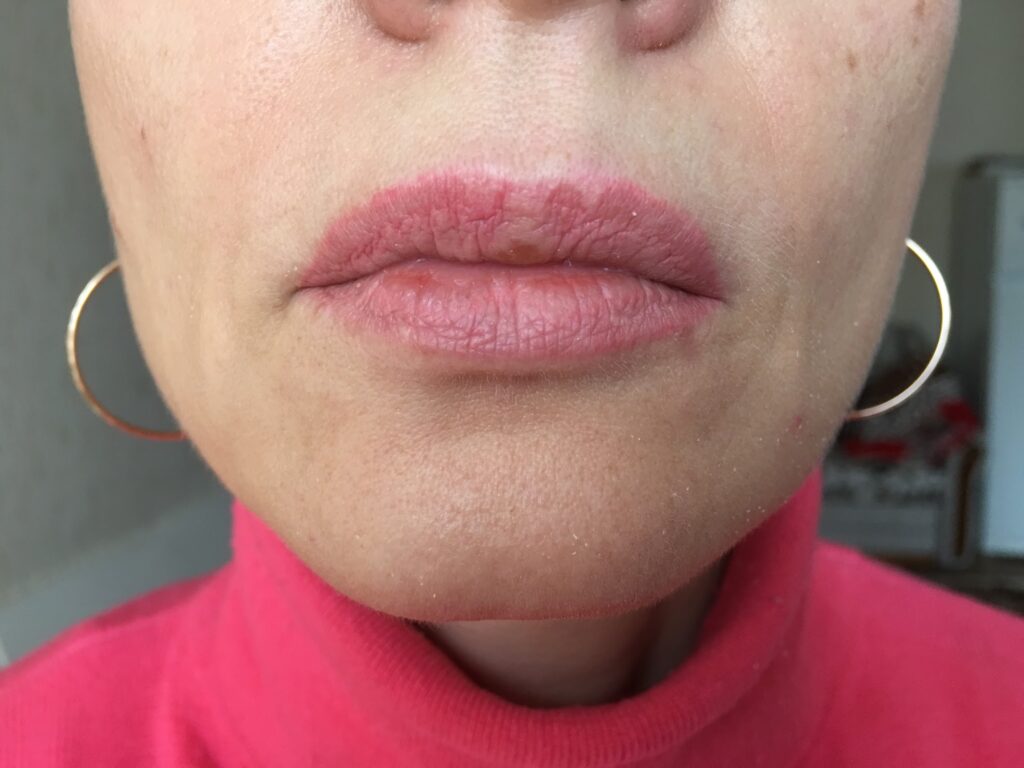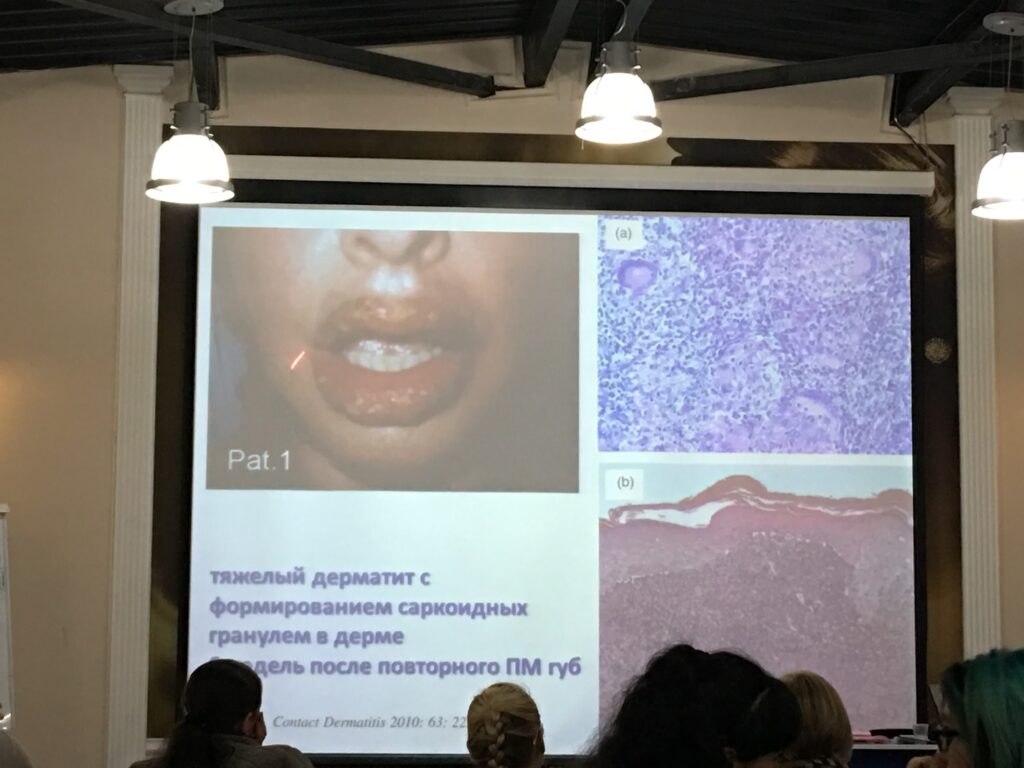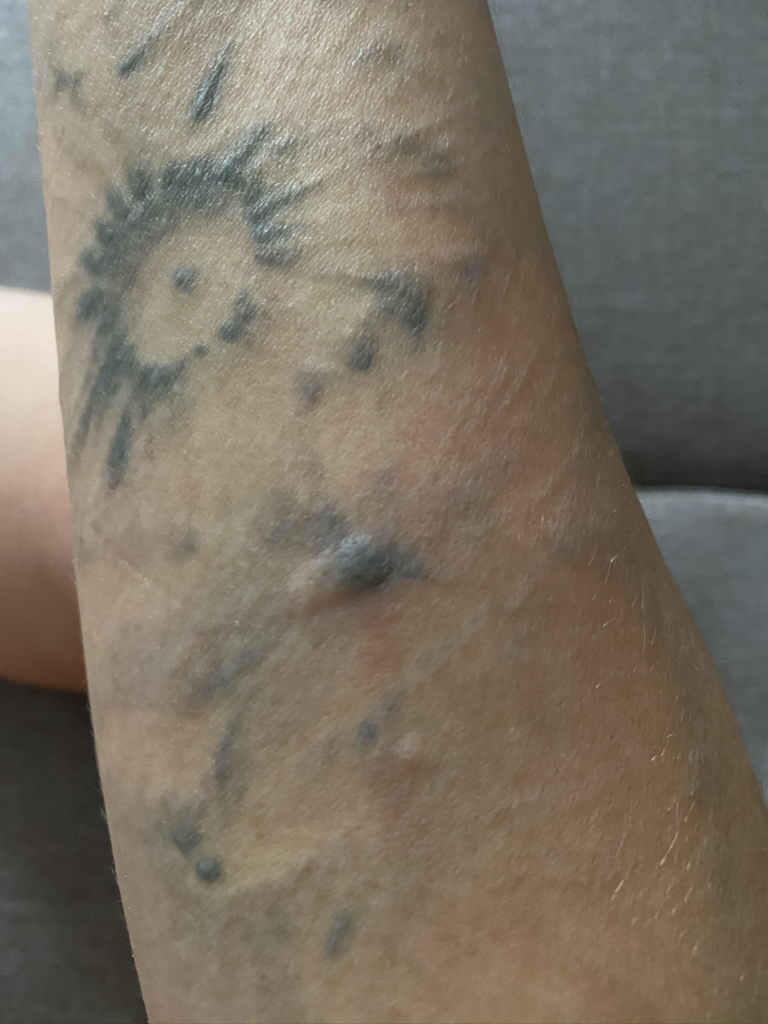Allergic reactions after laser removal
Allergic reactions to permanent makeup or tattoo pigments can sometimes occur after laser removal. How to spot them and what a tattoo artist should know in order to apply timely treatment?
Masters often perform an allergy test for the client. This can be a test strip, lightly applying pigment to the skin in a small area. The linergist inserts the pigment into the client’s skin to perform the allergy test.
Allergic reactions – allergy test for the customer
Yes, this is one way to test for allergies. But this way of determining allergic reaction works if you want to detect an allergy to a pigment before a procedure. The “BEFORE PROCEDURE” allergy test. This method works well if you are doing permanent makeup or a small tattoo.
Please note. We cannot 100% determine the body’s reaction to the tattoo pigment.

Based on my research, I conduct training for permanent makeup specialists.
No matter what expensive and high-quality pigments we use – allergic reaction of the body exists. After removal by laser or with the help of a remover – allergic reactions are very common. Therefore, the client should always be advised to take antihistamines during pigment removal.
I receive many emails and personal messages from both champions and clients. The key question is: how to treat, what to do, what is it? I would like to post photos. Unfortunately, I cannot openly publish all the photos from my practice on the Internet.
I would like to point out that in many cases clients go to a dermatologist. And do not get the right answer. The fact is that the doctor does not know the chemical composition of the pigment. Why it happened and how to treat it? Not every specialist can give a complete analysis.
Allergic reactions. Cases
In my practice, I have come across many cases. So many people asked for help online, as no one could give a complete consultation.
Allergic reactions were on the face (eyebrows, lips, eyes), and there were also allergic reactions on the body. Let me say right away that the treatment of an allergic reaction after pigment removal – can take from 6 months or more.
Each allergic case must be treated individually. In Poland, many medications can only be prescribed by a dermatologist, and treatment can take at least six months. Sometimes clients may conclude that after three days everything is over, but this is not true. Allergic reactions can appear again, and the course of treatment must vary. Treating an allergic reaction after tattoo or permanent makeup removal is a complex chemical process.

Allergic reactions. An example from my experience
A woman consulted me after removing permanent makeup on her lips with a laser. The permanent makeup removal was performed in London using a picosecond laser. The resulting side effect was a complex allergic reaction. Please note that she went to many specialists and did not get the advice she needed. I prescribed her treatment for 6 months. A complicated regimen, but it was effective and without complications. This girl is doing well now.
PMU pigments and tattoo pigments
There are pigments from some companies that require additional medication to prevent allergic reactions. An allergic reaction to a pigment may not show up right away, but after 2-3 years. It can also be.
Therefore, in case of intensive sun exposure, it is best to use UV-protective creams.
Allergic reactions. Preventive tips
However, if there has been an allergic reaction and the client has negative skin reactions, the treatment should be tailored to the type of allergy.
Important to know. Dermatitis will subside over time, not all at once. There is no magic, only patience on the part of the client and the specialist. For example, if you have a lichenoid reaction, you should at least take antihistamines.
A radical measure is to inject glucocorticosteroids under the supervision of a dermatologist or surgeon.
No one is safe from allergies
Neither the client nor the specialist is immune to allergic reactions.
If you have an allergic reaction, it does not mean that the master used unsterile equipment or poor quality pigment. It doesn’t. Permanent makeup and tattooing are very beautiful, but you need to be aware of the side effects and catch the prevention away.
Types of allergic reactions
The most common allergic reaction is contact dermatitis. Immediately after application of the pigment, redness, itching and poor healing of the tattoo may occur. In simplest terms, there is a rejection of the pigment.
Photodermatosis is an allergic reaction to the pigment and is caused by exposure to UV light. Therefore, it is important for both the specialist and the client to know that after permanent makeup, tattoo and laser removal procedures and remuvera protect the skin surface from sunlight.
No tanning!
Photodermatitis – allergic reactions after laser
occurs most often on red and black pigments. Protect your lips and hands. Wear protective eyewear and use UV-protective lipstick. Protect fresh tattoos with light clothing, and use SPF 50 sunscreen after healing. Tattoos are beautiful, but when an allergic reaction occurs, it’s not beautiful at all. Therefore, I always recommend a sensible approach to tattooing in terms of beauty.
Lichenoid reaction
It is a mild allergic reaction. It is most often caused by red pigment. Sometimes there can be an allergy to black pigment.
Note that it is not always immediate. Also, there may be a lichenoid reaction after healing.
Lips you had permanent makeup done and after 1-2 months the client may notice a slight bulge in the skin. You may think it’s bad permanent makeup and the skin is mangled. Disaster. Sometimes the masters think that the healing process was not good after the procedure. No! A slight bulge of skin in the lip area can be a lichenoid reaction (usually with red pigment).

Lichenoid reaction occurs when flowers are applied to the skin, Japanese tattoos, permanent lip makeup is also at risk. Sometimes it is eyebrows, when red-orange pigment is used to correct eyebrows. These are the simplest examples from practice.
Granulomatous reaction – allergic reactions after laser
After exposure to antigen, T lymphocytes, macrophages, epithelioid cells and giant multinucleated cells are activated, leading to granuloma formation.
Granulomas are chronic inflammatory reactions involving cells of the macrophage system and other inflammatory cells.
The reaction is more complex and is accompanied by the appearance of granulomas on the skin in the pigmented area.

Note, this reaction can occur both after tattoo removal and after healing.
Symptoms: The skin reaction is very similar to the formation of a keloid scar. However, it is an allergic reaction. We may observe enlargement of the tissue in the pigmented area, accompanied by severe itching.
Treatment is tailored to the individual case
Ex: eyebrows are done or removed and a bulge has formed. After tattoo removal, a bulge may appear a week later. Therefore, it is very important to take pictures after removal and prescribe for the client the appropriate care after the removal procedure.
A granulomatous reaction is very common after removal. Proper aftercare and preparation for the procedure is important here.
Allergic reactions after laser. Koebner’s phenomenon
Köbner’s Symptom is a common risk of psoriasis at the tattoo site. this allergic reaction can occur in clients who already have psoriasis. I wrote about this in the article – can tattoo or permanent makeup be done if the client has psoriasis. More information can be found here.
Otherwise, ulcerative and necrotic reactions occur (the red pigment, sometimes green, is at risk again). What might this look like? The red tattoo is made deep and ulceration and severe induration appear at the application site then the pigment along with the skin is rejected. This reaction can also occur after removal of the pigment after 1-2 weeks.
RARE ALLERGIC REACTIONS
Allergic papulopustular reaction (Papulopustular)
A papule is a skin lesion protruding above the surface of the skin, clearly demarcated, usually of greater cohesiveness, not containing fluid. Spots and papules should be distinguished from lesions occurring in the course of acute allergic reactions – the so-called urticarial wheals.
Nodular reaction – is a reaction of the skin to chronic scratching caused by itching after tattoo removal. Patients who have been experiencing severe itching for a long time develop dermatological lesions on the skin, mainly in the form of papules, nodules and scabs.
I received a letter from a lady
“I came across your article about allergies after laser tattoo removal. Have hives on my skin. I have been removing my tattoo for 2 years with a picosecond laser. I want to get a new tattoo design, but I’m afraid of the reaction of the skin. Can you write something about this subject? Or how to remedy it? And why does this urticaria appear for so long? Will it stop coming out? I would appreciate your contact. Greetings, Agnes
I started tattoo removal in 2017 and the last session was in 2019, the urticaria appeared I think after 4 sessions
( there were 7 in total). The tattoo is only with black ink. Usually there was severe itching and the urticarial blisters popped( rather single). After several minutes the itching stopped and the urticaria disappeared within a few hours. There are also intervals of several months and they are longer and longer. Urticaria does not appear at all . I will send a photo of what it looked like.” (Translation of a letter from Polish into English)

Papulopigmentary allergic reaction (Papulkowo-grudkowa reakcja)
Papulopigmentary allergic reaction occurs mainly to black dye. It occurs rarely. Most often after laser removal. If it occurs in these cases, it is necessary to take antihistamines three days before removal and one week after removal.
There are three groups of antihistamines – first-generation LPH, second-generation LPH and the newest second-generation antihistamines, which include rupatadine and bilastine.
First-generation antihistamines
First-generation antihistamines are a numerous group of drugs with different chemical structures. These include ethanolamine, ethylenediamine, piperidine and phenothiazine derivatives.
Nonetheless, first-generation antihistamines are often used for violent allergic reactions, as the effect is activated up to 30 minutes and the re-administration time averages 3 hours. In addition, the drugs show greater efficacy than second-generation drugs, especially for skin diseases with severe pruritus.
Second-generation antihistamines are recommended when symptoms are relatively mild and you want to skip the central nervous system burden in the patient – this is especially true for rhinitis. These drugs are divided into three groups, namely: long-acting orally applied (e.g., astemizole, terfenadine), topically applied to mucous membranes (levocabastine, azelastine) and short-acting drugs (acryvastine).
Flucinar
Flucinar ointment is good for allergic reactions in the case as you described above. Use the gel (Flucinar) in the first phase of treatment after laser removal (before the ointment). Apply a small amount of gel to the affected skin; initially 2-3 ×/d; after the acute inflammation has subsided, apply the ointment or gel 1-2 ×/d. Treatment lasts no longer than 2 weeks (on facial skin max 1 week). In 1 week, you can use up to 1 tube (15 g) of ointment or gel. And it is important to remember that it is very difficult to remove the pigment to clear skin. It doesn’t matter whether you use laser or remover.
Removal techniques are very complex
The larger the area of pigment to be removed, the more difficult it is to remove. More treatments are needed. It is important to know the chemistry of the pigments and the equipment with which the specialist works. As a rule – tattoos are lightened as much as possible with a laser to make a new tattoo.
Permanent makeup is easier to remove, but it is important to know the pigments. And it also requires a lot of patience on the part of the client and the specialist. The removal process is longer and more expensive than good quality permanent makeup or tattooing.
Greetings, Millecenta ( Alesia Khakhlova)
I just started learning English in 2023. If you find errors in the text, please write in the comments to this text. I have only been learning Polish for a year, I speak German. My native language is Belarusian. I speak a little German, want to speak many languages, would be very grateful if you would leave comments on this article.
I sincerely hope that you found the information important.
Write a review in the comments and tell me if you have encountered allergies in your practice. Share the information with your friends.
To stay in touch – my FB page. You are invited. FB PMU SCHOOL ONLINE

I am curious to find out what blog system you’re using? I’m having some small security problems with my latest website and I’d like to find something more secure. Do you have any solutions?
I must say, permanent makeup is a game-changer! Your article beautifully highlights the numerous benefits and convenience it offers. The idea of waking up with perfectly defined eyebrows, luscious lips, or flawlessly lined eyes is incredibly appealing. Not only does it save valuable time and effort in our daily beauty routine, but it also provides a boost in self-confidence. The fact that before and after permanent makeup is long-lasting and resistant to smudging or fading makes it even more appealing. Your informative piece has certainly aroused my interest and has me seriously!
Yοur style is very unique in comparison to other folks I’ve read
stuff from. Many thanks for posting when you
have the opportunity, Guess I’ll just bookmark this blog.
I’m still learning from you, while I’m improving myself. I absolutely liked reading all that is posted on your blog.Keep the posts coming. I enjoyed it!